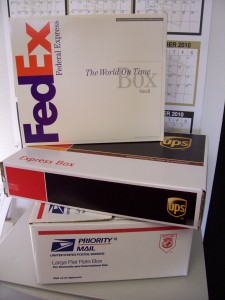 In 1919, a parcel shipping company from Seattle branched out to Oakland, California, and adopted a new name. By 1930, the United Parcel Service would be delivering packages across the country, the same year it adopted the color brown for its delivery trucks. Today UPS is a household name, a company that has its own fleet of airplanes and serves more than 200 countries worldwide.
In 1919, a parcel shipping company from Seattle branched out to Oakland, California, and adopted a new name. By 1930, the United Parcel Service would be delivering packages across the country, the same year it adopted the color brown for its delivery trucks. Today UPS is a household name, a company that has its own fleet of airplanes and serves more than 200 countries worldwide.
UPS came about in the days when there were few options for shipping a bulky package long distances. The USPS offered Parcel Post for items too large or heavy to be sent through regular mail, but while this service was economical, it employed slower means of transport, and typically took significantly longer for the package to arrive at its destination than regular mail. Overland delivery was still relatively new, but the growth of roads and the growing popularity of the automobile made the process safer, more reliable, and most importantly, faster, than it had ever been.
1973 saw UPS gaining a new competitor of its own in the parcel delivery business when Federal Express opened for business. Much like UPS had done half a century earlier, Federal Express took advantage of the emerging popularity of another advance in transportation technology to offer its service. This time around, it was jet travel. Federal Express used it's cargo jets to expand the niche of overnight delivery of packages and letters.
While there is some overlap in the services they provide, companies like UPS and FedEx are not exactly direct competitors to the Postal Service. For one, the Postal Service is the only entity permitted to deliver to business and residential mailboxes. This, in addition to the volume of mail processed every year, gives the Postal Service a significant advantage in delivering correspondence. Meanwhile UPS and FedEx, once filling somewhat different needs in package delivery, have grown to serve nearly identical roles to each other. UPS added their Next-Day Air service to their more economical ground delivery options in 1982, while FedEx expanded into ground-based delivery with the acquisition of a network of associated companies in 1998. Both companies will ship items far too large to qualify for Parcel Post.
Today's Postal Service offers a variety of options, such as Express Mail and Priority Mail, that were inspired in-part by the competition that arose in the 20th Century from companies like UPS and FedEx. But the USPS would soon face yet another breed of competitor at the dawn of the 21st Century.